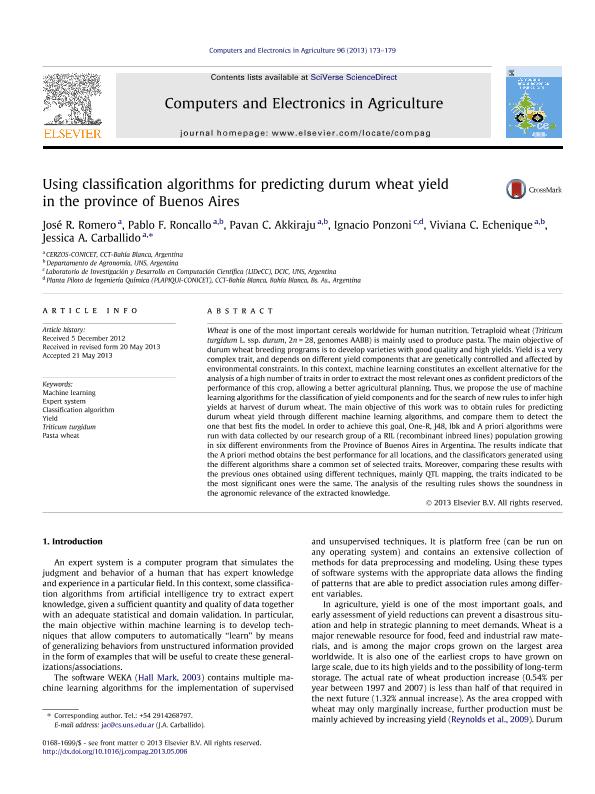Mostrar el registro sencillo del ítem
dc.contributor.author
Romero, José Rodolfo

dc.contributor.author
Roncallo, Pablo Federico

dc.contributor.author
Akkiraju, Pavan C.
dc.contributor.author
Ponzoni, Ignacio

dc.contributor.author
Echenique, Carmen Viviana

dc.contributor.author
Carballido, Jessica Andrea

dc.date.available
2017-02-08T20:45:50Z
dc.date.issued
2013-05
dc.identifier.citation
Romero, José Rodolfo; Roncallo, Pablo Federico; Akkiraju, Pavan C.; Ponzoni, Ignacio; Echenique, Carmen Viviana; et al.; Using classification algorithms for predicting durum wheat yield in the province of Buenos Aires; Elsevier; Computers And Eletronics In Agriculture; 96; 5-2013; 173-179
dc.identifier.issn
0168-1699
dc.identifier.uri
http://hdl.handle.net/11336/12720
dc.description.abstract
Wheat is one of the most important cereals worldwide for human nutrition. Tetraploid wheat (Triticum turgidum L. ssp. durum, 2n = 28, genomes AABB) is mainly used to produce pasta. The main objective of durum wheat breeding programs is to develop varieties with good quality and high yields. Yield is a very complex trait, and depends on different yield components that are genetically controlled and affected by environmental constraints. In this context, machine learning constitutes an excellent alternative for the analysis of a high number of traits in order to extract the most relevant ones as confident predictors of the performance of this crop, allowing a better agricultural planning. Thus, we propose the use of machine learning algorithms for the classification of yield components and for the search of new rules to infer high yields at harvest of durum wheat. The main objective of this work was to obtain rules for predicting durum wheat yield through different machine learning algorithms, and compare them to detect the one that best fits the model. In order to achieve this goal, One-R, J48, Ibk and A priori algorithms were run with data collected by our research group of a RIL (recombinant inbreed lines) population growing in six different environments from the Province of Buenos Aires in Argentina. The results indicate that the A priori method obtains the best performance for all locations, and the classificators generated using the different algorithms share a common set of selected traits. Moreover, comparing these results with the previous ones obtained using different techniques, mainly QTL mapping, the traits indicated to be the most significant ones were the same. The analysis of the resulting rules shows the soundness in the agronomic relevance of the extracted knowledge.
dc.format
application/pdf
dc.language.iso
eng
dc.publisher
Elsevier

dc.rights
info:eu-repo/semantics/openAccess
dc.rights.uri
https://creativecommons.org/licenses/by-nc-nd/2.5/ar/
dc.subject
Machine Learning
dc.subject
Expert System
dc.subject
Classification Algorithm
dc.subject
Yield
dc.subject.classification
Ciencias de la Información y Bioinformática

dc.subject.classification
Ciencias de la Computación e Información

dc.subject.classification
CIENCIAS NATURALES Y EXACTAS

dc.title
Using classification algorithms for predicting durum wheat yield in the province of Buenos Aires
dc.type
info:eu-repo/semantics/article
dc.type
info:ar-repo/semantics/artículo
dc.type
info:eu-repo/semantics/publishedVersion
dc.date.updated
2016-12-01T19:40:40Z
dc.journal.volume
96
dc.journal.pagination
173-179
dc.journal.pais
Países Bajos

dc.journal.ciudad
Amsterdam
dc.description.fil
Fil: Romero, José Rodolfo. Consejo Nacional de Investigaciones Científicas y Técnicas. Centro Científico Tecnológico Bahía Blanca. Centro de Recursos Naturales Renovables de la Zona Semiárida(i); Argentina
dc.description.fil
Fil: Roncallo, Pablo Federico. Consejo Nacional de Investigaciones Científicas y Técnicas. Centro Científico Tecnológico Bahía Blanca. Centro de Recursos Naturales Renovables de la Zona Semiárida(i); Argentina. Universidad Nacional del Sur; Argentina
dc.description.fil
Fil: Akkiraju, Pavan C.. Consejo Nacional de Investigaciones Científicas y Técnicas. Centro Científico Tecnológico Bahía Blanca. Centro de Recursos Naturales Renovables de la Zona Semiárida(i); Argentina. Universidad Nacional del Sur; Argentina
dc.description.fil
Fil: Ponzoni, Ignacio. Universidad Nacional del Sur. Departamento de Ciencias e Ingenieria de la Computacion. Laboratorio de Investigación y Desarrollo en Computacion Cientifica; Argentina. Consejo Nacional de Investigaciones Científicas y Técnicas. Centro Científico Tecnológico Bahía Blanca. Planta Piloto de Ingeniería Química (i); Argentina
dc.description.fil
Fil: Echenique, Carmen Viviana. Consejo Nacional de Investigaciones Científicas y Técnicas. Centro Científico Tecnológico Bahía Blanca. Centro de Recursos Naturales Renovables de la Zona Semiárida(i); Argentina. Universidad Nacional del Sur; Argentina
dc.description.fil
Fil: Carballido, Jessica Andrea. Consejo Nacional de Investigaciones Científicas y Técnicas. Centro Científico Tecnológico Bahía Blanca. Centro de Recursos Naturales Renovables de la Zona Semiárida(i); Argentina
dc.journal.title
Computers And Eletronics In Agriculture

dc.relation.alternativeid
info:eu-repo/semantics/altIdentifier/url/http://www.sciencedirect.com/science/article/pii/S0168169913001257
dc.relation.alternativeid
info:eu-repo/semantics/altIdentifier/doi/http://dx.doi.org/10.1016/j.compag.2013.05.006
Archivos asociados
